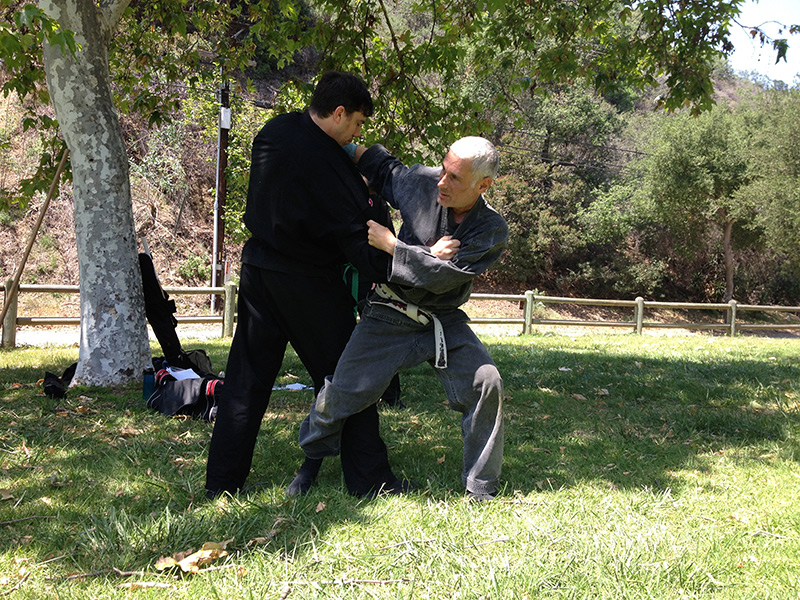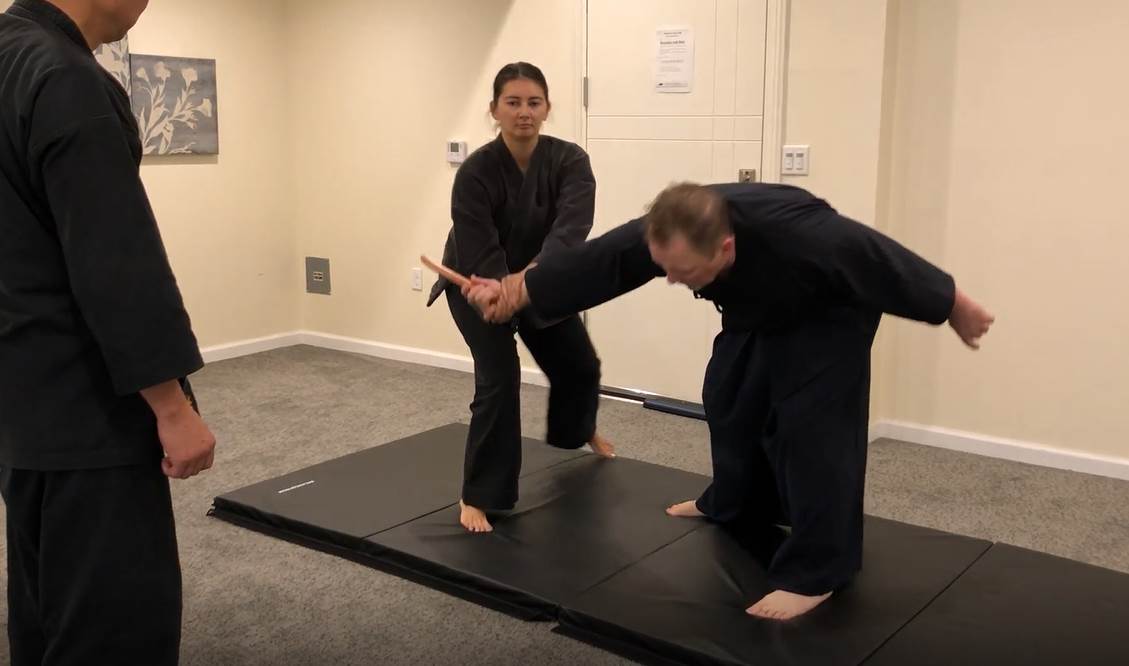Training Approach.
Our approach to self-defense training combines the immutable laws of motion, gravity, and spatio-temporal distribution with natural body mechanics and psychological tactics to promote effective, safe, reliable and humane responses to threats. Simply put, Bujinkan training relies on natural body movement (not muscles). in fact, females tend to excel in this art due to the lack of reliance on muscle mass. Unlike rigid martial arts programs, we thrive on an environment of constant change, positive reinforcement, skill scaffolding, and cooperative play.
An established curriculum for progression through the art begins by learning the basics for practicing safely (e.g. stretching, break falls, postures, footwork, evasion, and basic self-defense techniques). Next, we progress through applied fundamentals (e.g. strikes, kicks, blocks, locks, grappling) and advanced fundamental scenarios (e.g. free-form responses against punch/kicks/weapons). Traditional weapons are introduced throughout to advance the concepts.
WHAT DOES A TYPICAL BUJINKAN CLASS ENTAIL?
A topic, school, weapon or other aspects are discussed and demonstrated by the instructor.
Practitioners then rotate practicing what was demonstrated with different partners with further exploration and coaching from the instructor.
Learning to respond to controlled attacks with fellow students of different sizes, genders and skill-levels helps to advance the individuals perspectives and abilities with the topics being studied.

UNARMED-UNARMED TRAINING.
Practitioners train with other students to learn distance, timing and agility concepts. Fundamental skills training focuses on gaining the experience necessary to evade, attack and counter-attack effectively against one or more opponents. The curriculum is broken into concepts that focus on the skeletal system, muscular system, nervous system, psychological aspects, and psycho-behavioral concepts of interactions. By training distance, timing and agility concepts, students develop skills in self-awareness and self-regulation. Affording better clarity about consequences and providing the capacity to choose different courses of action in life.

WEAPONS-AGAINST-WEAPONS TRAINING.
Once foundational skills are developed, padded and wooden practice weapons are used to further enhance distance and timing concept skills. These include swords, spears, sticks, blades and throwing weapons. Weapons training is premised upon fundamental skills and generally leads to more advanced unarmed skills.

UNARMED-AGAINST-WEAPONS TRAINING.
At the higher levels, intention becomes imperceptible and practitioners begin to employ the concepts developed in the lower levels in myriad situations against one or more armed attackers. Among other aspects, practitioners apply concepts of using a weapon while none exists. For example, attitudes such as "your weapon is my weapon" and other psychological stimuli are employed as mechanisms to effect behavioral responses.

ADVANCED WEAPONS TRAINING.
Blunted steel weapons may also be used in advanced training. Sharpened steel is only taught in advanced level coursework (e.g. tamashigiri sword cutting or shuriken throwing practice).
WHAT TO WEAR TO TRAINING?
Wear comfortable clothing with no metal/jewelry/accessories that could injure you or others in the class. It is recommended that beginners wear a Gi or other loose fitting clothing. Durable active wear appropriate for the rigors of physical exercise such as yoga or gym clothes are also acceptable. Bear in mind, we are practicing in the park where you are going to come in contact with grass, dirt and other natural elements.
WHAT TO BRING TO TRAINING?
Please bring sufficient water to maintain hydrated during the class. Bujinkan training is an exercise, during which, your muscles generate heat which increases body temperature. It is important to ensure you stay well hydrated during exercise for optimum health.
Notepad/pen. In order to retain information and build upon what you learn more rapidly, is important that you jot down notes during breaks. Remember the art that we practice comes to us from several hundred years of development in Asia and is comprised of 9 completely distinct systems of self-defense.
Great, so how do I get started?
- This email address is being protected from spambots. You need JavaScript enabled to view it. and let us know when you would like to audit a class and to receive directions.
-
First class FREE for new members - If invited to continue it is $10/class fee thereafter.
-
Regular training is always FREE for visiting Bujinkan Members.
-
Open to newcomers and visitors on Wednesdays 6:00pm -8:00pm (90004 zip code) and Sundays 9:00am-11:30am (90027 zip code). Send introduction email for invite and directions.
-
Open to visiting Bujinkan members on Wednesdays 6:00pm -8:00pm (90004 zip code) and Sundays 9:00am-11:30am (90027 zip code). Send introduction email for invite and directions.
-
Continued training beyond the first-class trial period, is by invitation only.

